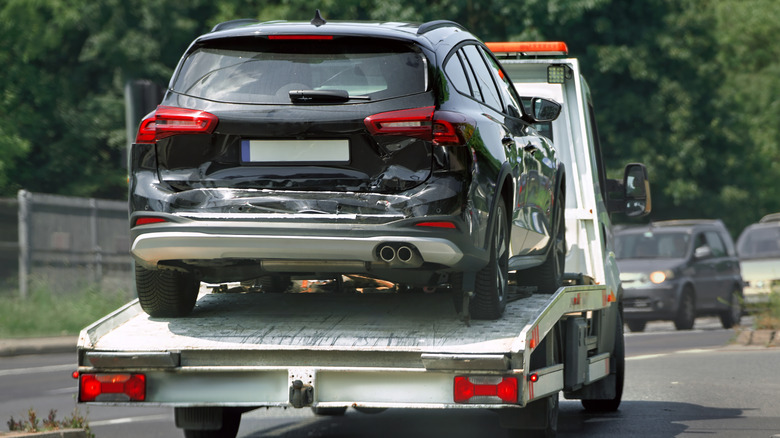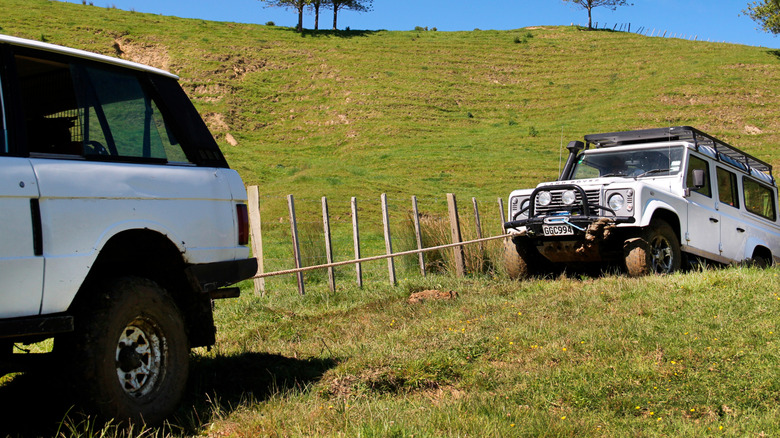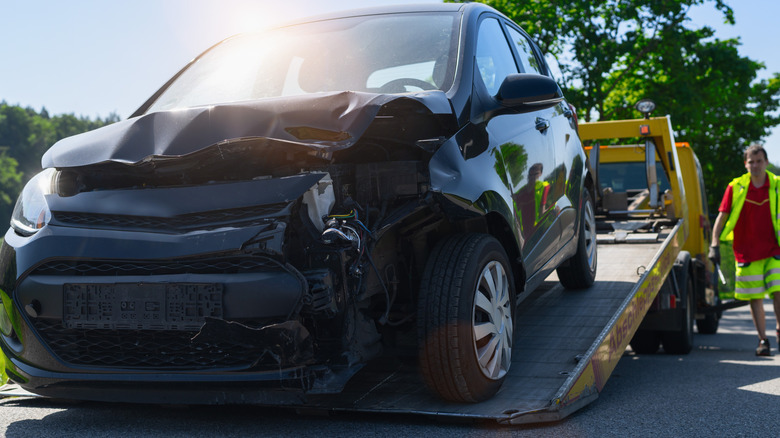Can You Tow A Car With Another Car?
Many vehicle owners have experienced it one time or another: You get into your car and turn the key ignition on, only to hear a slow cranking noise. Even worse, nothing happens. While most might call AAA, some drivers might find it more convenient and affordable to reach out to friends or family for help. This often results in towing your car with another car to get you out of the bind you're in.
Dragging your vehicle with another — particularly with a rope or chain — might sound like a simple fix. After all, if you have a willing friend, car-to-car towing might be the fastest way to get your vehicle to a repair shop. While it's safe to hook up a rope and pull your car to the next garage, there are many things to consider if you're towing your vehicle with another vehicle that isn't designed for towing. You could potentially damage both vehicles or end up with a license suspension.
Towing isn't an everyday adventure, but it pays to know how to do it correctly and safely. Furthermore, you never know when your car will break down, refuse to start, and need to be towed.
What to consider before towing a car with another car
Before you go ahead and hitch your vehicle to another, you must think beyond just hooking up a tow strap. Even with the best intentions, it can be all too easy to overlook some key aspects of towing a car, especially if it looks like a minor job at first glance.
One of the most common mistakes car owners make is overlooking their transmission system. CVTs and automatic transmissions in particular are sensitive, so flat towing them — towing your car while all four tires are touching the ground — will cause serious wear and tear on the transmission, eventually damaging it. This is mainly because these transmissions rely on internal lubrications that are usually powered by the engine to prevent overheating and premature wear. A car that's being flat towed, however; its engine isn't running and isn't lubricating most parts of your transmission system. This leads to overheating, gear damage, and even worse, full transmission failure. If you're going to tow a car with a CVT or automatic transmission, the best method is to use a tow dolly or flatbed trailer.
In addition to checking the transmission system, you'll also want to consider the drivetrain layout. Vehicles with rear-wheel drive, front-wheel drive, and all-wheel drive all have varying towing requirements. Tow an AWD with all wheels on the ground, for instance, and you run the risk of damaging your transmission and drivetrain. The safest way to avoid these issues is to follow the manufacturer's guidelines. Otherwise, use a flatbed tow truck or a vehicle with dollies to avoid costly transmission damage and repairs.
Other things to know before towing a car with another car
As mentioned earlier, a lot can go wrong during towing — especially when a friend is involved. One major risk that most drivers overlook is overloading their brake system. This mostly happens when the lead car isn't designed to handle the extra towing weight. And if the towing car's brakes aren't rated for the extra dead load, things like brake fade, overheating, and complete loss of braking power could happen — especially when you make sudden stops. That's why it's crucial that you use an auxiliary braking device or brake assist systems for the trailing vehicle.
Besides checking your transmission and drivetrain, another crucial thing to consider is the towing capability. Ensure that the vehicle doing the towing is more powerful than the broken-down model. It's much easier if you use something like the trucks with the best towing capacities to tow another vehicle, as they are designed for towing heavy trailers.
It doesn't hurt to use the right gear for towing either. Generally, using a tow rope or chain should be a last resort, and if the need arises, it should be when covering short distances. Instead, opt for DOT-approved tow straps that come with weight ratings or use a tow bar. Keep in mind that rusty and thin ropes might snap, and create a dangerous scene.
For safe towing, tow lights, proper hitch lights, and safety chains are non-negotiable for security and visibility. However, although a heavy-duty tow strap will help pull a damaged vehicle, experts recommend using a flatbed or a tow bar for safe transport. Double-check your local laws, as some states require safety chains and special lighting while towing. Breaking these rules could lead to heavy fines.


